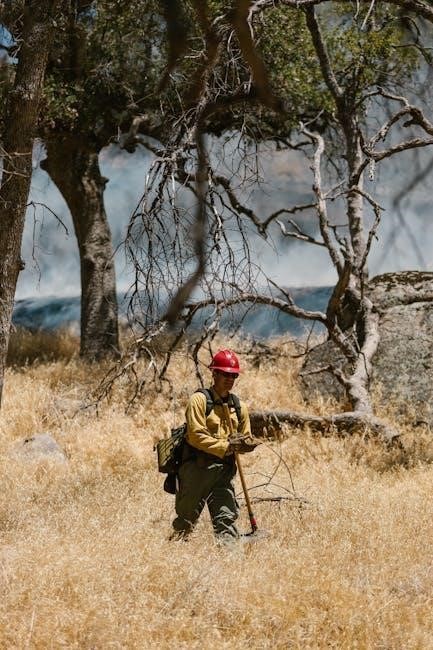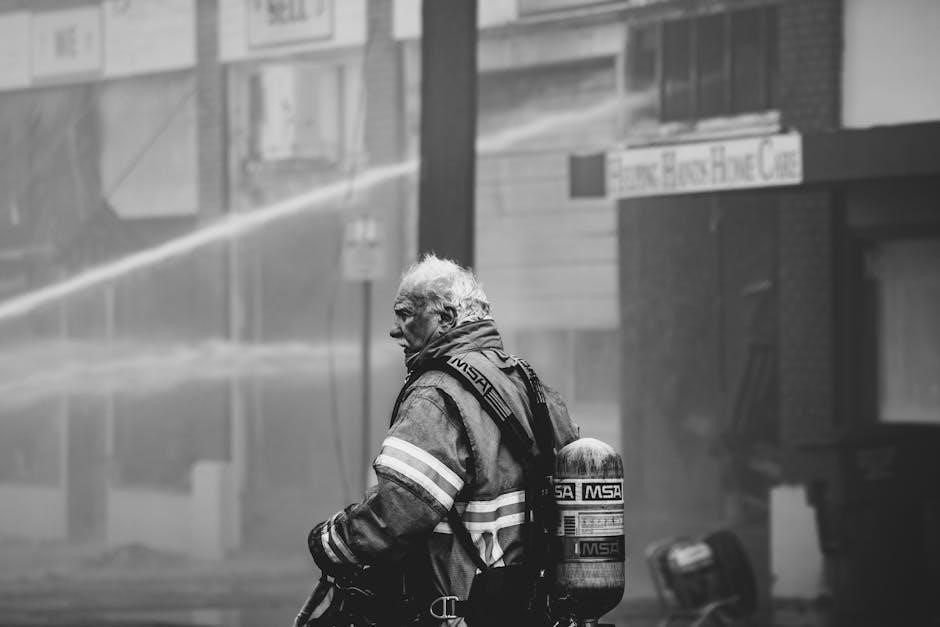
national fire protection association nfpa 25 pdf
National Fire Protection Association (NFPA) 25 PDF: A Comprehensive Guide
The National Fire Protection Association (NFPA) 25 PDF provides essential guidelines for water-based fire protection systems. It covers inspection, testing, and maintenance to ensure system integrity and optimal performance.
NFPA 25, officially known as the “Standard for the Inspection, Testing, and Maintenance of Water-Based Fire Protection Systems,” is a critical document developed by the National Fire Protection Association. This standard provides comprehensive guidelines for ensuring that water-based fire protection systems, such as sprinkler systems and standpipes, are properly maintained and function effectively when needed. Compliance with NFPA 25 is essential for maximizing the integrity and reliability of these systems, which are vital for life safety and property protection. The standard outlines specific requirements for inspection frequencies, testing procedures, and maintenance protocols, helping to prevent system failures and ensure optimal performance during fire emergencies. NFPA 25 plays a key role in fire safety by providing a framework for maintaining the operational readiness of water-based fire protection systems.

What is NFPA 25?
NFPA 25 is a standard for the inspection, testing, and maintenance of water-based fire protection systems. It ensures these systems function effectively when needed, enhancing fire safety.
Standard for the Inspection, Testing, and Maintenance of Water-Based Fire Protection Systems
NFPA 25, officially titled the “Standard for the Inspection, Testing, and Maintenance of Water-Based Fire Protection Systems,” establishes the criteria for ensuring the reliability of these crucial systems. This standard provides detailed guidelines for maintaining fire sprinklers, standpipes, and fire pumps. Regular inspections, tests, and maintenance, as outlined in NFPA 25, are essential for verifying that these systems are in proper working order, ready to respond effectively in the event of a fire.
The standard addresses various aspects of system upkeep, including visual inspections, component testing, and corrective actions to address any deficiencies. By adhering to NFPA 25, building owners and facility managers can significantly reduce the risk of system failure and improve overall fire safety. This proactive approach helps ensure that water-based fire protection systems perform as intended, protecting lives and property; Compliance with NFPA 25 is a critical component of a comprehensive fire protection strategy.

Importance of NFPA 25
NFPA 25’s importance lies in maximizing the integrity of water-based fire protection systems through consistent inspection, testing, and maintenance. This compliance ensures systems are ready when needed most.
Maximizing System Integrity Through Compliance
Compliance with NFPA 25 is paramount for maximizing the integrity of water-based fire protection systems. This standard provides a structured approach to inspection, testing, and maintenance, ensuring these systems function effectively during a fire emergency. Regular adherence to NFPA 25 guidelines helps identify and address potential issues before they compromise system performance.
By following NFPA 25, building owners and facility managers can significantly reduce the risk of system failure, protecting lives and property. This proactive approach ensures that fire protection systems are always in optimal condition, ready to respond when needed. NFPA 25 compliance is not merely a suggestion; it’s a critical investment in safety and security. It also avoids legal problems.

Availability of NFPA Standards
NFPA makes its codes and standards available online, offering free access to important safety documents. This facilitates convenient access to NFPA 25 and other crucial resources for fire protection.
Free Online Access to NFPA Codes and Standards
The National Fire Protection Association (NFPA) provides free online access to its extensive collection of codes and standards, including NFPA 25. This initiative ensures that vital safety information is readily available to the public, promoting better understanding and implementation of fire protection measures. By offering free access, NFPA aims to enhance safety practices across various industries and communities.
This online accessibility allows individuals and organizations to conveniently view and utilize NFPA documents, fostering a more informed approach to fire safety. The NFPA’s commitment to providing free resources underscores its dedication to safeguarding lives and property from the devastating effects of fire. This initiative supports continuous improvement in fire protection practices. The availability of NFPA 25 online is particularly beneficial for those involved in the inspection, testing, and maintenance of water-based fire protection systems, ensuring they have the necessary information to maintain system integrity.

Key Areas Covered by NFPA 25
NFPA 25 addresses key areas such as inspection requirements, testing procedures, and maintenance guidelines for water-based fire protection systems. Compliance ensures optimal system performance and reliability.
Inspection Requirements
NFPA 25 mandates thorough inspection requirements for water-based fire protection systems. These inspections aim to identify any deficiencies that could compromise the system’s functionality during a fire emergency. The standard outlines specific inspection frequencies for various components, including sprinklers, valves, and piping. Visual inspections are crucial to detect physical damage, corrosion, or obstructions that may impede water flow. Detailed records of inspections must be maintained, documenting any issues found and corrective actions taken. Proper inspection ensures that the fire protection system is always ready to operate effectively, providing critical fire suppression capabilities when needed. Regular inspections, as detailed in NFPA 25, are essential for maintaining the integrity and reliability of these vital safety systems. These inspections help minimize risk and ensure compliance with safety regulations, ultimately protecting lives and property from fire hazards.
Testing Procedures
NFPA 25 defines comprehensive testing procedures for water-based fire protection systems, ensuring their operational readiness. These tests assess the functionality of various components, including fire pumps, alarm systems, and sprinkler heads. Hydrostatic testing verifies the integrity of piping and connections, while flow tests measure the system’s ability to deliver adequate water volume and pressure. Regular testing, as mandated by NFPA 25, helps uncover hidden problems that visual inspections may miss. Detailed documentation of all testing activities, including results and any corrective actions, is essential. Proper testing ensures that fire protection systems will perform as designed during a fire, providing reliable suppression capabilities. Adherence to NFPA 25’s testing procedures is crucial for maintaining the effectiveness and reliability of these life-saving systems. Through rigorous testing, potential failures are identified and addressed promptly, contributing to enhanced fire safety and protection of property and occupants. These procedures are key to validating system performance.
Maintenance Guidelines
NFPA 25 provides detailed maintenance guidelines to ensure the long-term reliability and effectiveness of water-based fire protection systems. These guidelines encompass a range of activities, including regular cleaning, lubrication, and component replacement. Proper maintenance prevents corrosion, blockages, and mechanical failures that can compromise system performance. Specific maintenance tasks include inspecting and maintaining fire pumps, control valves, and sprinkler heads. The guidelines also address the importance of keeping systems free from obstructions and ensuring proper drainage. Regular maintenance helps extend the lifespan of fire protection systems and minimizes the risk of costly repairs. Detailed records of all maintenance activities, including dates, tasks performed, and any parts replaced, should be maintained. Adhering to NFPA 25’s maintenance guidelines is essential for ensuring that fire protection systems remain in optimal working condition. Neglecting maintenance can lead to system malfunctions during a fire emergency, endangering lives and property. Proper adherence contributes to enhanced safety.

Significant Updates in Recent Editions of NFPA 25
Recent editions of NFPA 25 include significant updates impacting inspection, testing, and maintenance of water-based fire protection systems. These revisions enhance safety and system reliability through improved standards.
NFPA 25 2023 Edition: Overview of Changes
The 2023 edition of NFPA 25 represents a significant update to the Standard for the Inspection, Testing, and Maintenance of Water-Based Fire Protection Systems. These revisions aim to enhance the effectiveness and reliability of fire protection measures. Key changes address inspection frequencies, testing protocols, and maintenance procedures for various system components. The updates reflect advancements in technology and evolving industry best practices.
Specific areas of focus include improved guidance on impairment handling, clarified requirements for assessing corrosion, and refined testing methods for backflow preventers. These changes are crucial for ensuring that fire protection systems operate as intended during an emergency. By incorporating these updates, stakeholders can better protect lives and property from the devastating effects of fire, adhering to the latest safety standards. Understanding these changes is vital for compliance and effective fire safety management.

Copyright and Usage of NFPA 25 Documents
NFPA 25 documents are copyrighted and licensed for individual use. Downloading requires agreement to specific terms. These agreements often restrict distribution and modification of the standard.
Licensing Agreements for Individual Use and Download
Accessing NFPA 25, particularly in PDF format, typically involves accepting a licensing agreement. These agreements outline the terms and conditions for using the document, focusing on individual use and download permissions. The National Fire Protection Association (NFPA) retains copyright, and the license grants specific rights.
Users are often permitted to download a single copy for personal reference. However, redistribution, modification, or commercial use may be strictly prohibited without express written consent from the NFPA. The agreements specify the scope of permitted activities.
Furthermore, the license might be tied to a specific individual or organization, preventing unauthorized sharing. Compliance with the licensing agreement is crucial to avoid copyright infringement. Such agreements ensure the NFPA’s ability to maintain and update the standard, supporting its ongoing development and availability. The licensing helps sustain the quality.

Legally Binding Nature of NFPA 25
NFPA 25 becomes legally binding when incorporated by reference into federal regulations. This means it must be followed by all citizens and residents where it is referenced.
Incorporation by Reference into Federal Regulations
The legally binding nature of NFPA 25 stems from its incorporation by reference into federal regulations. This process essentially adopts the NFPA standard as part of the law, making compliance mandatory. When a federal regulation cites NFPA 25, it means that the standard’s requirements become enforceable under federal law. This is a critical aspect of ensuring fire safety across various industries and applications.
Incorporation by reference provides a streamlined way for regulations to stay current with the latest advancements and best practices in fire protection. Rather than rewriting detailed technical specifications into the regulations themselves, agencies can simply refer to the NFPA standard, which is regularly updated and maintained. This mechanism ensures consistency and promotes adherence to recognized safety standards, enhancing overall fire protection efforts.

NFPA’s Role in Fire Protection
The NFPA develops codes, standards, recommended practices, and guides to minimize the risk and effects of fire. These documents, like NFPA 25, are vital for fire safety.
Development of Codes, Standards, Recommended Practices, and Guides
The National Fire Protection Association (NFPA) plays a critical role in fire protection by developing a comprehensive suite of documents. These include codes, standards, recommended practices, and guides, all meticulously crafted to address various aspects of fire safety. NFPA documents, such as NFPA 25, are developed through a consensus-based process, ensuring that they reflect the collective expertise of fire protection professionals.
These documents serve as vital resources for professionals and organizations involved in fire safety, offering guidance on best practices and requirements. They are regularly updated to incorporate the latest advancements in fire protection technology and knowledge. The NFPA’s commitment to developing these resources underscores its dedication to minimizing the risk and impact of fire across various industries and communities, promoting safety and protecting lives and property. The NFPA’s work is fundamental to effective fire safety strategies.
NFPA 25 and Water-Based Fire Protection Systems
NFPA 25 provides vital standards for maintaining water-based fire protection systems. It ensures systems are effectively inspected, tested, and maintained, ensuring they function correctly and remain free of water when necessary.
Ensuring Systems are Free of Water When Required
A crucial aspect of NFPA 25 involves ensuring water-based fire protection systems are free of water when required. This is particularly important in systems designed to remain dry until activated by a fire event. The standard outlines specific procedures and checks to verify that these systems are indeed dry, preventing potential damage from leaks, corrosion, or freezing. NFPA 25 also clarifies that the responsibility for ensuring the system is free of water does not fall on the service provider unless explicitly stated in their agreement. Adherence to NFPA 25 guidelines ensures that water-based fire protection systems function as intended, providing reliable fire suppression when needed and preventing unintended water release. This proactive approach maintains system integrity and minimizes the risk of false alarms and associated disruptions. Regular inspections and maintenance, as detailed in NFPA 25, are essential for verifying the dry state and overall operational readiness.

Related NFPA Standards
NFPA 25 works in conjunction with other standards like NFPA 72 (Life Safety Code), NFPA 101, and NFPA 70 (National Electrical Code) to provide comprehensive fire safety.
NFPA 72: Life Safety Code
NFPA 72, known as the Life Safety Code, is integrally linked with NFPA 25, addressing fire alarm and signaling systems. This standard outlines the requirements for fire detection, alarm notification, and emergency communication systems to ensure building occupants’ safety during a fire event. The Life Safety Code provides crucial guidelines for designing, installing, and maintaining these systems, complementing NFPA 25’s focus on water-based fire suppression.
NFPA 72 details proper system supervision, testing, and maintenance to guarantee reliability. Regular inspections and testing, as mandated by NFPA 72, ensure that fire alarm systems are always operational, promptly alerting occupants to potential fire hazards, enabling timely evacuation, and minimizing injuries or fatalities.
NFPA 101: National Electrical Code
There seems to be a misunderstanding. NFPA 101 is actually the Life Safety Code, not the National Electrical Code. The National Electrical Code is NFPA 70. Assuming you meant NFPA 70, here’s the text:
NFPA 70, the National Electrical Code (NEC), indirectly relates to NFPA 25 through its requirements for the electrical components of water-based fire protection systems. The NEC ensures the safe installation and operation of electrical wiring, equipment, and systems powering fire pumps, alarm systems, and other electrically driven components within fire protection setups. NFPA 70 sets standards to minimize electrical hazards that could compromise the functionality of these systems.
Compliance with the NEC is crucial to prevent electrical failures that might disable fire protection mechanisms during emergencies. Proper grounding, overcurrent protection, and wiring methods, as outlined in NFPA 70, contribute to the overall reliability of water-based fire protection systems.
NFPA 70: National Electrical Code
NFPA 70, the National Electrical Code (NEC), plays a vital role in the reliability and safety of water-based fire protection systems covered by NFPA 25. The NEC sets the standard for safe electrical installations, ensuring that all electrical components associated with fire protection systems are correctly installed and maintained. This includes wiring for fire pumps, alarm systems, and control panels, all of which are critical for the effective operation of water-based fire suppression.
Proper adherence to NFPA 70 reduces the risk of electrical failures that could impair the functionality of fire protection systems during an emergency. Requirements for grounding, overcurrent protection, and appropriate wiring methods are essential for preventing electrical hazards. By ensuring a stable and reliable power supply to fire protection equipment, NFPA 70 complements the inspection, testing, and maintenance procedures outlined in NFPA 25.
NFPA does not offer professional services. NFPA codes and standards are developed through a consensus process and are intended to enhance safety, but compliance does not guarantee complete protection;
NFPA Not Rendering Professional Services
The National Fire Protection Association (NFPA) emphasizes that while it develops and publishes codes, standards, recommended practices, and guides like NFPA 25, it is not undertaking to render professional or other services on behalf of any person or entity. NFPA’s role is to provide information and knowledge resources, but it does not act as a professional service provider. Users of NFPA standards are responsible for seeking qualified professional expertise to ensure proper application and compliance with these standards. The NFPA does not guarantee that following these standards will ensure safety or prevent all potential hazards. The application and interpretation of NFPA standards require professional judgment and expertise, which NFPA does not provide directly. Therefore, users should consult with licensed and experienced professionals in fire protection and related fields for specific guidance and implementation of NFPA 25 and other NFPA documents.
Related posts:
Archives
Calendar
| M | T | W | T | F | S | S |
|---|---|---|---|---|---|---|
| 1 | 2 | 3 | 4 | 5 | 6 | 7 |
| 8 | 9 | 10 | 11 | 12 | 13 | 14 |
| 15 | 16 | 17 | 18 | 19 | 20 | 21 |
| 22 | 23 | 24 | 25 | 26 | 27 | 28 |
| 29 | 30 | 31 | ||||
Leave a Reply
You must be logged in to post a comment.